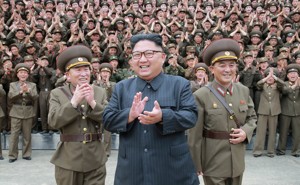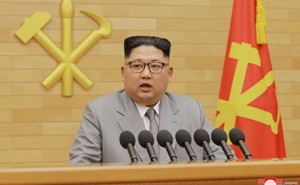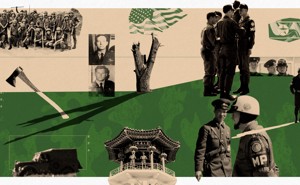The Beginning of the End of the Korean War
Reconciliation is happening faster than denuclearization. The United States might not be willing to accept that.URI FRIEDMANNOV 28, 2018
 A South Korean military officer and a North Korean military officer shake hands near the demilitarized zone separating the two Koreas on November 22.SOUTH KOREAN DEFENSE MINISTRY VIA REUTERS
A South Korean military officer and a North Korean military officer shake hands near the demilitarized zone separating the two Koreas on November 22.SOUTH KOREAN DEFENSE MINISTRY VIA REUTERSIn a sense, Donald Trump’s campaign to denuclearize North Korea is bearing fruit: The Korean War is beginning to end—not with the U.S. president achieving a dramatic breakthrough in nuclear negotiations, but with a series of incremental measures barely noticed outside the Korean peninsula.
Rather than Kim Jong Un trading in his nuclear weapons for a peace treaty, or the countries that fought each other in the 1950s finally proclaiming the end of the war, Seoul and Pyongyang have been dismantling guard posts, designating no-fly zones, and disarming what was once the most volatile place on the peninsula.
Indeed, by the estimation of the South Korean newspaper Hankyoreh, North and South Korea have already fully implemented about one third of the more than two dozen reconciliation agreements they reached in a pair of summitsbetween the nations’ leaders in April and September. By The Atlantic’s count, of the 13 commitments made during those summits that specified a time frame, the Koreas have successfully hit five deadlines, are on track to meet four more, and missed another by only a month. Having just received the UN Security Council’s blessing to carry out a joint field study on connecting their railroads, they are now scrambling to organize a ceremony inaugurating the project before the end of the year.
It’s hard to overstate what’s at stake in these seemingly minor developments. The resolution of one of the world’s most dangerous and persistent conflicts, the endurance of the U.S.–South Korea alliance, and the fate of the most ambitious effort ever to stop the spread of nuclear weapons are all tied up in the question of whether the demands of peace and denuclearization are ultimately complementary or incompatible.
MORE STORIES

The Threat to Kim Jong Un Within North KoreaURI FRIEDMAN

The Unbelievable Story of North Korea's Most Celebrated PropagandistMAX KIM

The Koreas Start TalkingKRISHNADEV CALAMUR

The ‘God Damn’ Tree That Nearly Brought America and North Korea to WarURI FRIEDMAN
Of course, several of the meatiest measures require U.S. consent and are on hold. North and South Korea, for example, can’t collaborate on economic and tourism projects or actually get inter-Korean roads and railways up and running until international sanctions against North Korea are eased. They’ve also encountered resistance in calling for the leaders of the two Koreas, the United States, and perhaps China to formally declare an end to the Korean War, which came to a halt in an armistice in 1953. (Trump-administration officials worry about prematurely reducing the pressure on North Korea and undermining the United States’ military alliance with South Korea.)
Get the latest issue now.
Subscribe and receive an entire year of The Atlantic’s illuminating reporting and expert analysis, starting today.Subscribe
Read: How to tell when North Korea starts to denuclearize
But where Kim and South Korean President Moon Jae-in have freer rein and have arguably made the greatest advances is in enacting various accords to cease military hostilities between their countries. The progress, though still modest and tentative, is all the more remarkable given the comparatively sluggish pace at the moment of nuclear negotiations between the United States and North Korea.
Moon, a liberal politician who favors engagement with North Korea, describedthese inter-Korean military accords during a visit to New York this fall as “akin to a declaration to end the Korean War.”
Over the course of November, North and South Korea each destroyed 10 guard posts within the Korean demilitarized zone—sometimes in spectacular fashion, with explosives—in order to build trust for their plans to eventually withdraw the roughly 200 that are thought to still be operational in the densely fortified border region.
The Koreas have suspended certain military exercises near the military demarcation line (MDL) separating the countries, cleared hundreds of land mines in the area (millions remain), and linked a road as part of an effort to excavate the remains of soldiers who died during the Korean War. They have covered up coastal artillery and warship-mounted guns and established a no-fly zone in the vicinity of the border. They are now exploring ways to jointly secure the iconic border village of Panmunjom and allow unarmed guards, civilians, and foreign tourists to move about on either side of the MDL there for the first time in more than 40 years.
Reflecting on all this work in October, Moon declared that he and Kim were making “clear that war would not come between the South and North.”
It is in marked contrast to this spring, when Lieutenant Colonel Matt Farmer, then the commander of U.S. and South Korean forces in Panmunjom, was showing me footage of his troops rescuing a bullet-riddled defector and nearly exchanging fire with North Korean forces pursuing the defector across the MDL. South Korean sentries peered vigilantly into North Korea, and a video at the nearby visitors’ center informed those passing through that they were about to enter “the most dangerous place” in South Korea.
“When you put people who are technically in a state of war right next to each other,” Farmer warned, noting that in some cases each side’s forces were in closer proximity than they were during the war itself, “a small thing can spark something larger.”
The United States and North Korea are themselves no longer threatening each other with catastrophic war, as they were only months ago, and Kim hasn’t tested a nuclear bomb or ballistic missile in a year. American and North Korean officials are engaged in protracted planning for a second meeting between Trump and Kim.
But here, progress is more uneven. North Korea has just as many (if not more) nukes and missiles as it had the day the two leaders first met in Singapore this past summer. A steady stream of evidence indicates that North Korea is persisting in developing aspects of its nuclear program in the absence of a detailed disarmament agreement with the United States. (Despite the headway in lessening tensions between the Koreas, the North continues to pose a military threat to the South as well—not just with nuclear-tipped missiles but also with conventional artillery that can reach Seoul.)
Read: North Korea is not denuclearizing.
Six months after North Korea claimed to have destroyed its nuclear-test site, Washington and Pyongyang are still haggling over whether independent inspectors will be allowed to verify the destruction. We’re quite a long way from U.S. National-Security Adviser John Bolton’s assessment, shortly after the Singapore summit, that North Korea’s entire nuclear-weapons arsenal could be eliminated within a year.
The United States also has yet to secure many of the commitments it once demanded North Korea make at the outset of talks, including a comprehensive inventory of the country’s nuclear-weapons program, the verified dismantlement of a significant portion of its nuclear arsenal, and a timeline for full denuclearization.
During a recent appearance at the Wilson Center in Washington, D.C., the head of South Korea’s Ministry of Unification, Cho Myoung-Gyon, acknowledged that the process of Korean reconciliation was moving faster than that of North Korean denuclearization. But he said this was to be expected, given the legacy of the war and past attempts at rapprochement between North and South Korea.
“It is natural to reunite something that was artificially separated, and for the past 10 years almost all inter-Korean communication and exchanges were suspended,” Cho observed. Inter-Korean détente was, he said, similar to “a river that was once blocked for a long time” and is now flowing again.
In the case of the United States and North Korea, he continued, “it is too early to expect [them] to establish trust after 70 years of hostility. There is a huge gap in their perspectives, and they lack mutual understanding.”
The two tracks, Cho argued, could go hand in hand. Even as he downplayed an end-of-war declaration as a mere “political” statement, for instance, Cho highlighted its capacity to grant Kim the “legitimacy” necessary for persuading top North Korean military officials to stake the nation’s future security on peace and economic development rather than nuclear weapons and international isolation.
U.S. officials, however, seem far less thrilled by the burst of activity on the Korean peninsula. Secretary of State Mike Pompeo, who previously scolded his South Korean counterpart during a private call for insufficiently consulting with the United States about inter-Korean military pacts, recently made the rare move of airing his grievances in public.
The Trump administration wants to “make sure that peace on the peninsula and the denuclearization of North Korea aren’t lagging behind the increase in the amount of interrelationship between the two Koreas,” he told reporters last Tuesday. It was a mealymouthed way to say: Not so fast, Mr. Moon.
Read: The man behind the North Korea negotiations
This is fundamentally what divides the two allies at the moment: The South Korean government contends that relieving pressure on North Korea is the best way to push forward on denuclearization, while the U.S. government considers it the surest way to fall backwards. Seoul is examining the fine details of when and how to open relief valves that Washington so far has shown little interest in touching.
Nowhere is this disconnect clearer than with economic sanctions against North Korea. Whereas Pompeo has referred to international sanctions as “the core proposition” that “will give us the capacity to deliver denuclearization,” Moon recently made the case to European leaders that these sanctions should be eased as a form of encouragement when Kim takes significant steps toward relinquishing his nuclear program. (North Korea, which abruptly canceled a November meeting with Pompeo, has threatened to make no further concessions on its nuclear program and even resume its weapons buildup unless sanctions are lifted.)
When tensions have erupted between the United States and South Korea over inter-Korean initiatives—whether involving the water supply to a liaison office or South Korean banks eyeing the North Korean market—they have stemmed from the Trump administration’s concerns about the Moon government watering down sanctions and puncturing holes in the broader U.S. pressure campaign against Kim.
Ultimately, Seoul views renewed military hostilities on the Korean peninsula as a greater threat to South Korea than North Korea’s nuclear weapons, argues Chun Yung Woo, a former South Korean national-security adviser who is a conservative critic of Moon. If U.S. officials grow “frustrated with North Korea’s intransigence [on denuclearization] … and Trump runs out of patience—he can no longer claim victory, and he has no other option but to return to military options, maximum pressure—then I think there will be a rift” in the alliance, he told me. “President Moon will be on a collision course with the U.S.”
As James Acton, an expert on nuclear policy, has observed, “You can be simultaneously optimistic about peace building between the Koreas and pessimistic about the denuclearization of the North. Big question, though, is whether the US can tolerate the former without the latter.”
We want to hear what you think about this article. Submit a letter to the editor or write to letters@theatlantic.com.

URI FRIEDMAN is a staff writer at The Atlantic, where he covers global affairs.
TwitterEmail
MOST POPULAR
No comments:
Post a Comment